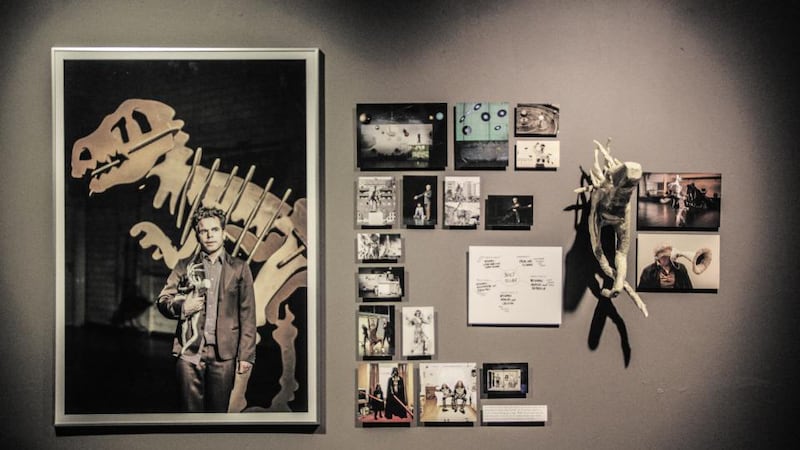Dance Uncovered . . . (Sensational) ****
DRAFF: An Exhibition *****
Douglas ***


Death Is Certain ****
Fragments – Volume 1 **
Renegade/Company B/La Macana ***
‘You have to love dancing to stick to it. It gives you nothing back, no manuscripts to store away, no paintings to show on walls and maybe hang in museums, no poems to be printed and sold, nothing but that single fleeting moment when you feel alive.”
In quoting Merce Cunningham, during Dance Uncovered . . . (Sensational), Philip Connaughton added to the many quotations evident throughout the first week of this year's Dublin Dance Festival. On opening night at the Abbey Theatre, the words and music of various composers coalesced in Meg Stuart's Built to Last, and in Jockey Emma O'Kane rediscovered the words of her grandfather, a bloodstock agent and racing journalist.
Connaughton, an Irish choreographer and dancer, presented a lecture performance that was chirpy, amusing and revelatory about what motivated him both to become a dancer and to continue.
The show appeared to be off the cuff, but in fact his anecdotes were carefully chosen, not just to tell his personal history, but to illustrate more general points about dance, such as nudity or how to evaluate performances. "Practice isn't the thing you do once you're good. It's the thing you do that makes you good," says Malcolm Gladwell in The Tipping Point, and repetition, through the grind of daily class, is part of a dancer's life. But it is also important for audiences: Connaughton says his mother was puzzled when first seeing him dance with Irish Modern Dance Theatre but now is a bit of an expert on contemporary dance. Also, an early onstage encounter with panto star Maureen Potter taught him the difference between performers who are completely true to themselves on stage and those who hide behind a metaphorical mask, a lesson he has never forgotten.
Dancing in the gallery
Connaughton was one of the seven choreographers featured in DRAFF: An Exhibition at Fumbally Exchange, an opportunity for dancers to rub against Cunningham's quote and
show something on gallery walls. The brainchild of dancer and choreographer Liv O'Donoghue, writer Rachel Donnelly (who is blogging about the festival on dublin dancefestival.ie) and theatre-maker José Miguel Jimenez, the exhibition presented background material to works featured during the festival.
In dialogue with the curators, each choreographer chose one main image, small images, sounds and a three-dimensional object to fit into a common template. These primary sources gave insight into each artist’s methodology. Liz Roche’s ordered lists contrasted with Maria Nilsson Waller’s notes in different coloured ink, ideas corralled into squares then reconnected through lines and arrows. The exhibition was perfectly realised, adding texture to upcoming performances while provoking after-images and reimaginings of those past. Frustratingly, it ended on Saturday and didn’t run until the end of the festival.
Robbie Synge's contribution to DRAFF included stage weights, rope and a blue boiler suit, perhaps an apposite distillation of Douglas, a conceptually straightforward work. Although he was the sole performer, it was really a series of group pieces featuring a human and objects, in particular two chairs and a roll of marley dance floor. Revelling in the tug-of-war instability caused by balancing his body against the objects, his workmanlike performance combined deadly seriousness with absurdity.
Absurd and scary
Equally serious and absurd (and a bit scary) was German artist Eva Meyer-Keller's Death Is Certain. Project's Cube was stripped back to a starkly white-lit space containing nothing but two white- clothed tables. On one, 35 cherries were surrounded by various devices that would be tools for their demise, while the other was the site for the killings. One by one each cherry was stripped of its stem and killed in a different way: drowned, electrocuted, blown up, crushed, hanged, suffocated by smoke inhalation, buried alive, sent skywards in a balloon that was burst. One was even sprayed with gold paint in a reference to the James Bond movie Goldfinger.
Before each act of killing, a white-aproned Meyer-Keller consulted notes, like a chef consulting a recipe, and carried out each slaying with an efficient matter-of-factness that was absurdly funny and vaguely chilling. The humour was both gallows (through the certainty of death) and absurd (through the efficiency of dispatch), but the simple premise raised questions around murder, suicide and executions.
Simple sparseness was promised onstage in Fragments – Volume 1, a series of four short dances by Sylvain Émard Danse, but music by Michel F Côté and Jan Jelinek and superb lighting by André Rioux overpowered the movement throughout. Each short dance sought to highlight the individual dancer, but the choreography was often overstated, particularly in Émoi, émoi, danced by Kimberley de Jong, and the final Bicéphale, performed by Manuel Roque and Georges-Nicolas Tremblay.
In Absence, actress Monique Miller was on edge, sitting in a chair with one hand grasping another in fearful uncertainty. Here choreographic material was more measured, and, although it occasionally veered towards wide-eyed over-dramatisation, it felt the most satisfyingly complete dance.
Movement was to the fore in a sun-drenched Smithfield as members of Renegade took to a square stage and strutted their stuff in an all-too-short dance jam that drew whoops and cheers from an appreciative audience.
Dublin-based Company B captured the post-referendum mood with a short piece called Inclusion of Exclusion, while personal freedom was also hinted at in a duet by Julio César Iglesias and Alexis Fernandez of La Macana from Spain.












